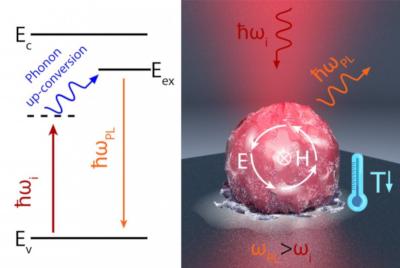A group of scientists from ITMO University in Russia has proposed a new method for quick cooling-down of surfaces using perovskite and light nanoparticles. This principle may be used to cool nano-lasers in optical chips, increase the lifetime of solar panels, and create smart glass.

The ITMO team, which has been conducting research into the creation of optoelectronic devices and ultra-compact lasers based on perovskites, has decided to make use of light, which is normally the agent that creates the heating-up effect putting the material in danger.
As a result of almost one year of work, the ITMO group managed to propose creating perovskite-based nanoparticles that would be cooled by means of infrared light. 'We have come to the conclusion that two things need to be optimized: light absorption through the creation of nanoparticles in order to absorb more photons with lower energy costs, and the luminescence efficiency of these nanoparticles so that less energy is spent on spurious heating. Thus, by maneuvering with these parameters, the size of the nanoparticle and the wavelength of the incident light, we have achieved the maximum increase in cooling efficiency,' says Pavel Tonkaev, an ITMO University Master's student and one of the co-authors of the study.
Based on the theoretical calculations conducted, the scientists have shown that the proposed nanoparticles can lose about a hundred degrees under the influence of infrared radiation. Potentially, this process can occur in fractions of a second. But in the case of a surface coated with these nanoparticles, the cooling process will take from several seconds to several minutes, depending on external conditions.
The development of the 'nano-refrigerator' is the continuation of the laboratory's projects conducted in collaboration with the third co-author of the article, ITMO University graduate Georgy Zograf. These projects focus on the development of the so-called 'nano-stove' (particles that are heated when exposed to light), and a 'nano-thermometer' that allows to directly measure the temperature at the nanoscale. Thus, as scientists joke, they are close to creating a kind of a 'nano-kitchen', which can be used to control the temperature of substances using nanoparticles and light.
If the first series of experiments is successful, this will bring scientists closer to solving the problem of cooling optoelectronic devices and optical radiation sources based on perovskites.
'In our laboratory, we create micro and nano lasers based on perovskites. They are necessary for the development of optical chips for the computers of the future. However, in order to make a device with such chips compact, it is important, among other things, to solve the cooling problem. The use of the optical cooling technology can potentially lead to the development of 'self-cooling' lasers,' explains Sergey Makarov, head of ITMO University's Laboratory of Hybrid Nanophotonics and Optoelectronics.
In addition, nanoparticles can possibly be modified so that they cool when exposed not to infrared light but to ultraviolet radiation or other radiation in the visible spectrum, which can be used to create 'smart glass' that can cool in the heat and heat up in the cold.

